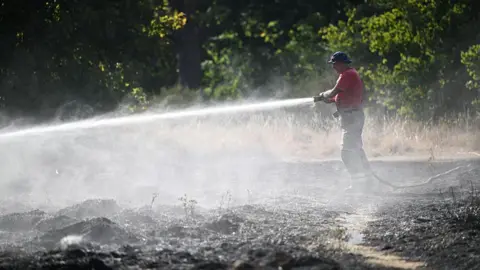
 Getty Images
Getty ImagesCities across the UK are facing a growing threat from an emerging phenomenon called “firewaves” as temperatures rise due to climate change, scientists have warned.
The term, coined by researchers at Imperial College London, describes multiple urban wildfires triggered by extended periods of hot, dry weather.
The warning comes as firefighters battled three separate heath fires in London and a dramatic gorse blaze on Arthur’s Seat in Edinburgh in recent days, as this summer’s latest heatwave left vegetation across both capitals dangerously dry.
These fires, though now contained, highlight the increasing vulnerability of urban areas to wildfires – a risk that was once considered largely rural.
Guillermo Rein, professor of fire science at Imperial College London, has been working alongside the London Fire Brigade to help predict when conditions are ripe for a “firewave”.
Based on current forecasts, he believes London could be at risk again by this weekend.
London Fire Brigade Assistant Commissioner Tom Goodall said he welcomes any research that helps predict the likelihood of wildfires occurring.
The service is “ready to tackle the threat of wildfires head-on to help protect London’s communities and green spaces”, he added.
Prof Rein’s research finds that, after ten consecutive days of very dry weather, vegetation becomes so desiccated across wide areas that the likelihood of multiple fires igniting simultaneously rises sharply.
Using detailed incident data from the London Fire Brigade dating back to 2009, combined with weather records, the team identified key factors that drive wildfire outbreaks in London.
One of the most important is a measure of how much moisture the atmosphere can extract from the land, known as the “vapour pressure deficit”.
The higher the deficit, the drier the vegetation becomes, and the more easily it ignites.
“Vegetation doesn’t just become a bit more flammable,” explained Professor Rein, “it becomes much more flammable.”
“Once the moisture content of the vegetation drops below a certain threshold, even a small spark can lead to a fast-spreading fire,” he added.
 BBC / Kevin Church
BBC / Kevin ChurchMost fires are started by humans, whether accidentally or deliberately. But a warming world is creating conditions more conducive to these blazes.
“Climate change is bringing more heatwaves and longer dry spells,” Prof Rein said.
“These conditions dry out fuels and increase the risk of wildfires. That risk is much greater now than it was even a decade ago.”
While the researchers focused on London, concerns are widespread.
“I worry about all other UK cities and other northern European cities in particular because climate change seems to be making green vegetation that was not flammable very flammable indeed,” said Prof Rein.
“And these places don’t have a history of dealing with wildfires so don’t have as much institutional experience as cities in the south of the continent.”
Managing fire risk
Urban environments like London, with their abundance of parks and green spaces bordering residential zones, are particularly susceptible.
The concept of a “firewave” is meant to capture the unique danger posed when several fires erupt at once in densely populated areas, which has the potential to overwhelm emergency services and threaten homes and infrastructure.
That happened in the summer of 2022 when UK temperatures exceeded 40C for the first time on record.
On 19 July 2022, London Fire Brigade (LFB) experienced its busiest day since World War II.
Fires broke out simultaneously across the city, including a devastating blaze in Wennington, East London, which destroyed 37 buildings, five cars, and forced the evacuation of 88 homes.
Blake Betts, a borough commander with the LFB, has extensive experience dealing with wildfires in urban settings.
He emphasises the serious threat they pose, especially when open spaces are adjacent to residential properties.
“The potential for fires to spread into homes is very real,” said Cdr Betts.
“We’re seeing more extreme weather events, and that’s why the London Fire Brigade has adopted a much more proactive approach.”
 BBC / Kevin Church
BBC / Kevin ChurchTo meet this growing challenge, the LFB says it has invested in new technologies and equipment.
Drones now play a critical role in wildfire response, providing real-time aerial views that help commanders map fire spread and direct resources where they are needed most.
“The bird’s-eye view from drones gives us a huge boost in situational awareness,” explained a spokesperson from the LFB.
“It allows us to target our efforts where the risk to life and property is greatest.”
In addition to drones, the brigade has introduced off-road vehicles capable of reaching fires in difficult terrain, such as heathland and grassland.
These vehicles can be used to create firebreaks – using water to soak the ground to help stop fires from spreading further.
The Imperial College London researchers argue that the Met Office’s current definition of a heatwave does not adequately reflect the wildfire risk in urban areas.
They propose it adopts the term “firewave” to signal periods of extreme fire danger in cities – a concept they hope will inform future public safety strategies and climate resilience planning.
The Met Office has been asked for comment.








